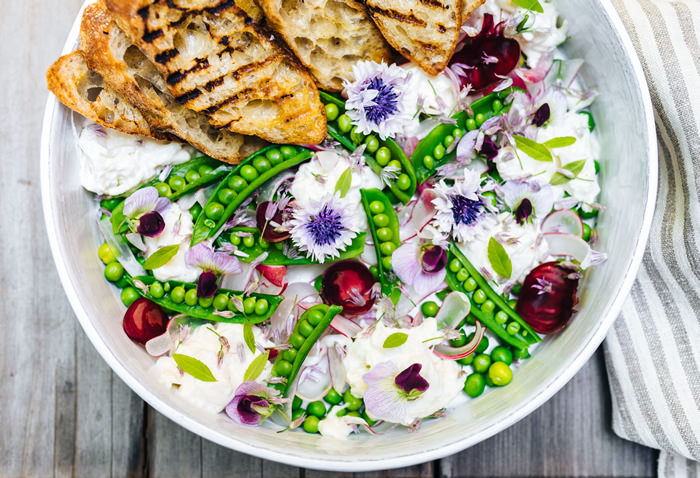edible travel
NATURAL NAPA
Unearthing heavenly, environmentally friendly wineries and eateries in one of the wine world’s top locales.
WRITTEN BY AMANDA BURDEN
You can’t throw a rock without hitting a grapevine in Napa Valley. It seems every $1 million acre of land is covered by the fruit. Many varieties grow here, including the coveted cabernet sauvignon grape, king in this climate and soil. Yet we were searching for something more distinct than a particular variety. We were set on ferreting out only organic, natural, biodynamic, sustainably grown, and green-practicing vineyards and wineries. We found quite a few that are not just natural and sustainable in some way, but also delicious. Stick with us and we’ll introduce you to a mostly undiscovered Napa.
More than 500 wineries operate in Napa, and the number of those growing organically and sustainably is small in comparison. However, winery owners and winemakers who follow these practices are passionate about the pursuit.
“It’s the circle of life; you have to do it,” says Craig Becker, co-founder, general manager, and director of winemaking for Somerston Wine Co. in St. Helena. “Every year a crop like grapes gives you something. You need to give back. You need to take, but give, too.”
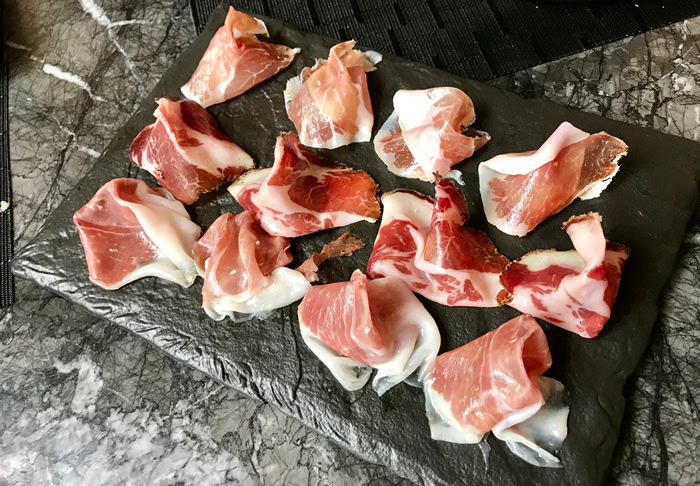
Salumi at Del Dotto Estate Winery&Caves. Photo by Jaci Goodman
Fertile ground
Somerston is sustainably farmed, which doesn’t just mean between the fence posts. The owners employ bees for pollination, sheep for weed control — and to reduce fire danger — and provide wooden boxes for owls to encourage pest control. They even created corridors for wildlife living on the natural woodland, such as turkeys, deer, mountain lions, coyotes, foxes, and bobcats. We visited in late June and, as turkey vultures swooped low over hills covered in golden grass, Becker drove us in a quad over the 1,600-acre property, tucked in the Vaca mountain range about 25 miles from one of Napa’s main thoroughfares, Silverado Trail. We climbed up and down steep ravines, passing old oaks heavy with olive-colored tufts of lichen. After the jaunt, we sipped wines in the tasting room. Though Somerston is known for its cabernet, the winemakers produce nine Bordeaux-styled wines that are highly sought after.

Somerston Wine Co.
Just down the hill, in Rutherford, is Round Pond Estate — a winery that follows sustainable farming and production practices. Here you’ll find cab and more. Sit upstairs on the beautifully furnished terrace and overlook the valley while tasting a flight and gourmet bites. The MacDonnell family, which has owned and cultivated the land since 1983, also grows 12 acres of olives (and even runs an olive mill) and 2.5 acres of citrus, flowers, and vegetables on the property. A walk through the vegetable garden is a must. When we visited, bumblebees swarmed purple-flowered artichokes, cornstalks, strawberries, and more.
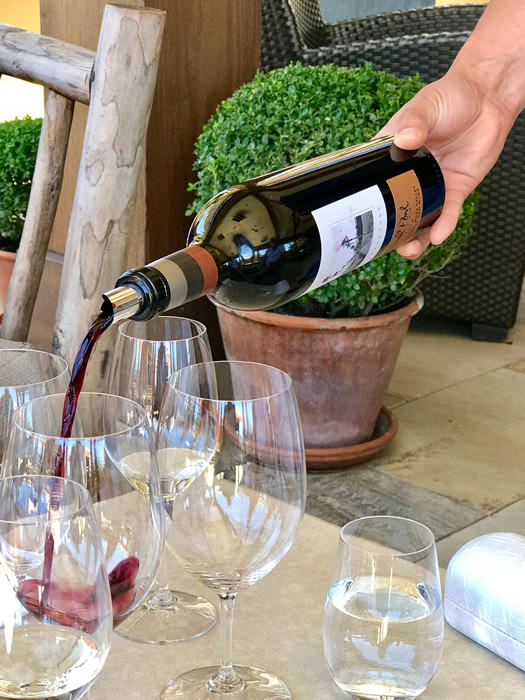
Round Pond Estate. Photo by Jaci Goodman
One of our favorite wineries in Napa is Robert Sinskey Vineyards on the Silverado Trail, which since 1991 has produced elegant, balanced wines created by organic and biodynamic methods, including using sheep as tractors and composters, hawks for pest control, and bees for pollination. The second-generation family that owns and operates this vineyard and winery is dedicated to caring for the soil. The results are luscious pinot noir, merlot, and cab, as well as beautiful blends and more. A big bonus is the food program, run by Maria Helm Sinskey, a celebrated chef and baker. We enjoyed the wonderful Eat Drink RSV program, soaking up the sun on the terrace while being pampered with a three-course, wine-pairing lunch that included smoked duck crostini with trumpet royale mushrooms, a lamb slider with mint yogurt, and a Spanish tortilla with spring onions, potatoes, and Romanesco.
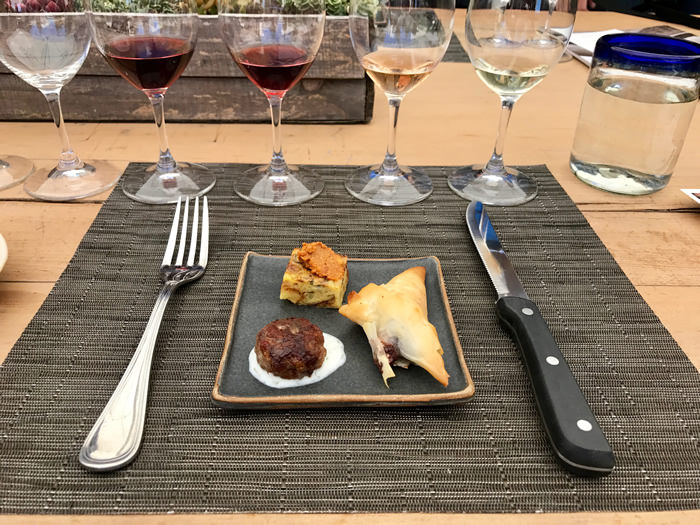 Robert Sinskey Vineyards. Photo by Jaci Goodman
Robert Sinskey Vineyards. Photo by Jaci Goodman
Sense of place
Another option for sustainably produced wines is Joseph Phelps Vineyards. The grand and tastefully appointed wooden building, designed by John Marsh Davis — who subscribed to the philosophy of organic architecture that promotes harmony between human structures and the natural world — underwent a 16-month renovation (completed in 2015). You’ll find a multi-roomed tasting space, along with a terraced patio peppered with comfortable seating and umbrellas dramatized by spectacular views. Since 1973, the family has farmed on hundreds of acres in the valley (at the home ranch in St. Helena and other properties). You’ll find excellent Rhone varietals, as well as Insignia, its flagship wine — a cab-dominated blend that won Wine of the Year by Wine Spectator magazine in 2005, as well as other awards. The family is dedicated to environmental sustainability, earning certification under the Napa Green and Fish Friendly Farming programs. Its practices include enhancing biodiversity by planting fruit trees, tending bees to promote the health of all the property’s plants and chickens for fertilizer, installing owl and bluebird boxes, employing sheep to mow the rows, composting grape skins and stems from the harvest, and using solar panels at the winery. In the summer, a culinary program was added for multi-course lunches and small-bite plates, all served from a state-of-the-art kitchen. The Terrace Tasting is a great way to try a selection of new releases while relaxing outside overlooking the vineyards.
Del Dotto Estate Winery & Caves in St. Helena (opened in 2007) was crafted to mirror an extravagant Venetian palace, complete with hand-blown Murano chandeliers, ancient Italian marble statues, and ornate custom ironwork at every turn. Grapes from the estate-grown, small-production winery are farmed from 100 acres on disparate properties throughout the valley. As a gardener himself, owner David Del Dotto says he appreciates natural growing methods and places a large emphasis on using environmentally friendly practices. Each vineyard is farmed without using chemical sprays or fertilizers, and weeding is performed by hand. We strolled through a glitzy wine cave to taste wines straight from the barrels, then returned to the wine room to savor selections from the dry-aged charcuterie program, as well as delectable super-Tuscan-style blends, sangiovese, merlot, cab, and more.
Just down the road is Piazza Del Dotto Winery & Caves in Oakville, which opened on Sept. 1 after five years of development. Food-and-wine pairing is the focus, and Del Dotto spared no expense on his culinary program, which will include visiting chefs from some of Napa’s best restaurants (including Thomas Keller). Stroll around the patio and past bird cages (with peacocks, pheasants, turkeys, doves, and chickens), then sit in a tasting cabana to try dishes prepared with ingredients such as Petrossian caviar, Hudson Valley foie gras, Snake River Farms beef, and fresh vegetables from the garden.
Napa pioneers
In stark contrast to the opulence of Del Dotto is Truchard Vineyards. A visit to the winery and vineyards is an intimate experience, with the owners’ home being just a stone’s throw away from the modest tasting room. Tony and Jo Ann Truchard were among Napa’s grape-growing pioneers, purchasing land in the cooler Carneros area in 1973. Since then, their property has grown to 400 acres, and 280 acres are planted with wine grapes. Of those, about 80 percent are sustainably grown and 20 percent are organically grown. They hold certifications from Napa Green for their land and winery, and for fish-friendly farming. The Truchards sold their grapes to premier wineries for 15 years before producing their own wines in 1989. Wine Spectator has highly rated their Chardonnay, and their reds are critically acclaimed as well, including pinot noir, syrah, merlot, tempranillo, malbec, and cab franc. They still sell about 60 percent of their grapes to Frogs Leap Winery and about 20 other wineries. You may have heard of their son, John Anthony, who also is an accomplished winemaker (best known for his widely accessible Butter, JaM, and Toast wines, as well as John Anthony estate wines).

Truchard Vineyards. Photo by Jaci Goodman
Bike friendly
We had a delightful experience at the Clif Family Velo Vino Tasting Room in St. Helena (Clif is best known for its energy bars). Our tasting of wines from the sustainably and certified-organically produced Clif Family Winery was paired with flavorful bruschetta from the Clif Family Bruschetteria truck parked outside. Ingredients in the dishes were sourced from the certified-organic Clif Family Farm. This is a great example of owners who truly care about the wine and food they produce.
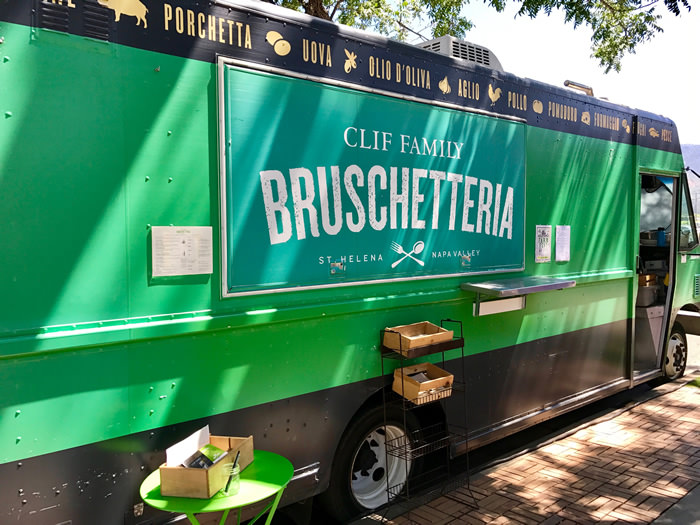
Clif Family Bruschetteria. Photo by Jaci Goodman
New choices
Liana Estates (opened in October 2016) was created by sisters Lisa and Ariana Peju of the family behind the award-winning and (certified-organic) Peju Province Winery. There’s an industrial vibe inside the tasting room, with stunning views of the San Pablo Bay. The two are producing several wines, including Chardonnay, pinot noir, lost grape varietals, and sparkling wine. They offer a choice of seasonal bites to savor with your wines and even have a whimsical cupcake-pairing program.
Durant & Booth in Oakville (also opened in 2016) is much different from those listed above, as the business isn’t affiliated with one winery or vineyard. Leslie Rudd (former owner of Dean & DeLuca) developed relationships with vineyard owners and grape growers throughout Napa and Sonoma to source grapes and collaborates with a winemaker to blend uncommon varietals. Wild yeast is used in the production of many of the wines. You can sample them in the tasting room, an elegantly renovated historic home (built in 1877), or on the covered patio. What adds to the visit is Oakville Grocery (California’s eldest continually operating grocery store), which is next door (along with California’s eldest post office). The grocery store (open since 1881) carries handcrafted, locally sourced food and wine. You can grab a picnic lunch from Oakville Grocery and a bottle of wine from Durant & Booth and enjoy them on the premises or embark upon the next escapade.
From vine to dine
Napa is so much more than great wine. You’ll find exceptional food in the valley as well, ranging from high end (The French Laundry) to casual. On our first evening in Napa, we slipped inside Ca’ Momi Osteria right in town. It’s a fun space full of action at the expansive bar, and the Italian restaurant celebrates local and organic ingredients from small producers. An ethical, nose-to-tail philosophy that is adhered to includes many offal choices (tripe, sweetbreads, beef tendons, and house-made sausage) along with less-adventurous choices. We started with lovely half glasses of sparkling wine, a flavorful pizza, and fried squash blossoms.
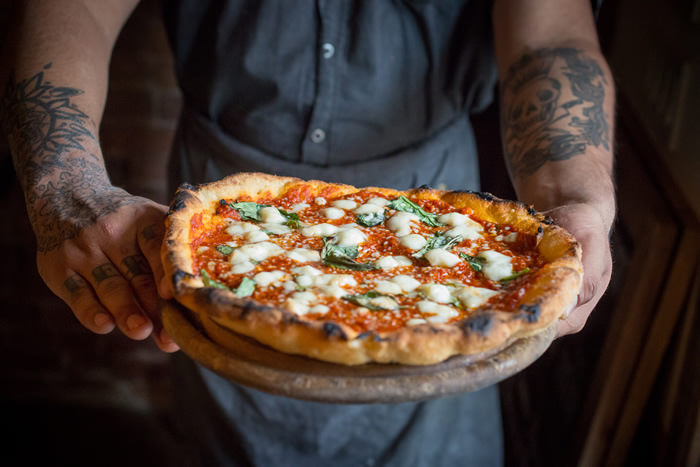 Pizza at Ca’ Momi Osteria
Pizza at Ca’ Momi Osteria
The next evening, we dined at TORC in Napa. The high-energy restaurant serves stellar contemporary American cuisine. Chef/owner Sean O’Toole changes the menu frequently and highlights the bounty of Napa’s local farmers and ranchers. He is a huge fan of mushrooms, so you will find many varieties of seasonal — and sometimes locally foraged — fungi in his dishes. Exceptional, protein-rich choices are abundant (wild Bodega Bay king salmon, heritage pork belly, prime dry-aged New York strip), but it’s the attention to detail with his vegetable dishes that made me long to return soon, including the chu-chu eggplant with burrata gratin, Aleppo pepper, and spearmint, and Iacopi Farms (in Half Moon Bay) English peas à la française, with little gem butter-leaf lettuce and Nantes carrots.
The following night, we settled in at Tarla Mediterranean Bar and Grill in Napa, which has a lovely wine menu (Wine Spectator approved) and even house-made beer. Local, seasonal, and organic ingredients are used whenever possible. The chef, Kadriye Baspehlivan, is Turkish born and trained at the Culinary Institute of America at Greystone in St. Helena. She offered a sublime grilled octopus salad, perfectly simple Greek salad with large cubes of feta, and a crusty baklava from her grandmother’s recipe.
For our final dinner in Napa, we dined at Lucy Restaurant & Bar at the Bardessono Hotel in Yountville. But before dinner, we took a tour of the small, on-property, certified-organic vegetable and fruit garden with executive chef Nate Lindsay, who says he came from a long line of gardeners. Here, he harvests ingredients and garnishes for his dishes. The menu at Lucy has a decided slant toward health- and diet-conscious dining, including many vegan and vegetarian options, and 80 percent of the selections are gluten free. You can dine in the restaurant or on the patio at this luxurious, LEED-platinum-certified property.
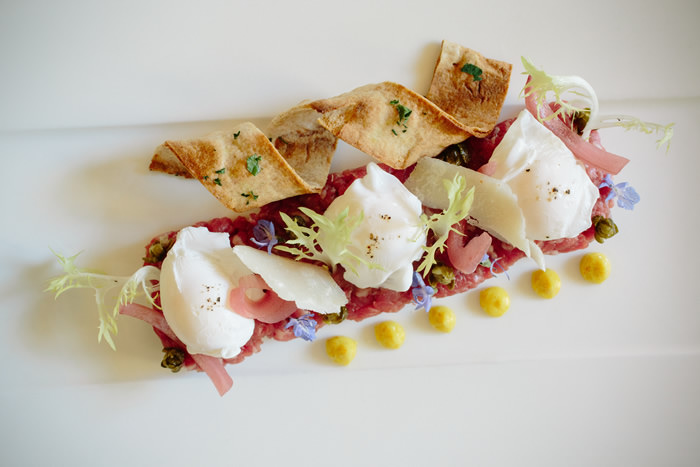
Lucy Restaurant & Bar
We had two generous hosts for our trip. The Napa River Inn put us up in a comfortable room overlooking the river for our first few nights. The property has an interesting history, dating back to 1884, and several restaurants and a bakery and sweets shop on site. The proximity to downtown Napa’s shops and restaurants was a plus. What topped it off were the beautiful flowers, including a rare, multiple-petal snowflake hydrangea, that surround the property.
We then moved to Hotel Yountville to be closer to several wineries on our list. Natural light filled our room, which was decorated with a pretty four-poster bed and impeccable furnishings. The hotel’s style is romantic and French-country retreat, and the French doors to the charming patio completed that feeling. The in-room breakfast from the hotel’s Hopper Creek Kitchen was delightful.
It’s hard not to overindulge in this wonderful valley. So, aside from the occasional stomachache from relishing too much of a good thing, we found that every forkful and glassful of deliciousness helped us learn more about the many great winemakers and food producers farming sustainably and the chefs supporting their work. We can’t wait to return to our favorite spots and track down more choices.
Amanda Burden is editor and publisher of edible Reno-Tahoe and publisher of edible Sacramento. At press time, fires were raging in wine country. Our hearts go out to those impacted.
Resources
To avoid crowds, the best time to visit Napa Valley is mid-fall to early spring. If you plan to visit, most of the wineries, listed below, require advance appointments. Most also offer wine clubs, which are a great way to support their efforts and take advantage of discounts and deals on special wines.
Wine
Food
Bardessono.com/lucy-restaurant-bar-yountville-california
Cliffamily.com/visit-us/#bruschetteria-food-truck
Accommodations
